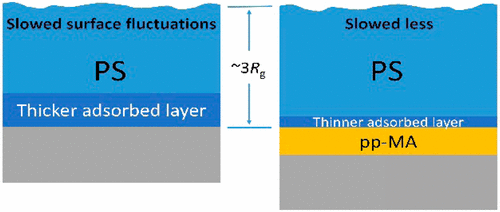当前位置:
X-MOL 学术
›
ACS Macro Lett.
›
论文详情
Our official English website, www.x-mol.net, welcomes your
feedback! (Note: you will need to create a separate account there.)
Modifying Surface Fluctuations of Polymer Melt Films with Substrate Modification
ACS Macro Letters ( IF 5.1 ) Pub Date : 2017-08-14 00:00:00 , DOI: 10.1021/acsmacrolett.7b00459 Yang Zhou 1 , Qiming He 1 , Fan Zhang 1 , Feipeng Yang 1 , Suresh Narayanan 2 , Guangcui Yuan 3 , Ali Dhinojwala 1 , Mark D Foster 1
ACS Macro Letters ( IF 5.1 ) Pub Date : 2017-08-14 00:00:00 , DOI: 10.1021/acsmacrolett.7b00459 Yang Zhou 1 , Qiming He 1 , Fan Zhang 1 , Feipeng Yang 1 , Suresh Narayanan 2 , Guangcui Yuan 3 , Ali Dhinojwala 1 , Mark D Foster 1
Affiliation

|
Deposition of a plasma polymerized film on a silicon substrate substantially changes the fluctuations on the surface of a sufficiently thin melt polystyrene (PS) film atop the substrate. Surface fluctuation relaxation times measured with X-ray photon correlation spectroscopy (XPCS) for ca. 4Rg thick melt films of 131 kg/mol linear PS on hydrogen-passivated silicon (H–Si) and on a plasma polymer modified silicon wafer can both be described using a hydrodynamic continuum theory (HCT) that assumes the film is characterized throughout its depth by the bulk viscosity. However, when the film thickness is reduced to ∼3Rg, confinement effects are evident. The surface fluctuations are slower than predicted using the HCT, and the confinement effect for the PS on H–Si is larger than that for the PS on the plasma polymerized film. This deviation is due to a difference in the thicknesses of the strongly adsorbed layers at the substrate which are impacted by the substrate surface energy.
中文翻译:

用基材改性来改变聚合物熔体薄膜的表面波动
在硅衬底上沉积等离子聚合膜显着改变了衬底顶部足够薄的熔融聚苯乙烯 (PS) 膜表面上的波动。用 X 射线光子相关光谱 (XPCS) 测量的表面波动弛豫时间为 ca。氢钝化硅 (H-Si) 和等离子聚合物改性硅晶片上的 131 kg/mol 线性 PS 的4 R g厚熔体薄膜都可以使用流体动力学连续统理论 (HCT) 来描述,该理论假设薄膜始终具有特征其深度由体积粘度决定。然而,当薄膜厚度减小到 ∼3 R g, 限制效应明显。表面波动比使用 HCT 预测的要慢,并且 PS 对 H-Si 的限制效应大于等离子聚合薄膜上的 PS。这种偏差是由于受基板表面能影响的基板上强吸附层的厚度不同。
更新日期:2017-08-14
中文翻译:

用基材改性来改变聚合物熔体薄膜的表面波动
在硅衬底上沉积等离子聚合膜显着改变了衬底顶部足够薄的熔融聚苯乙烯 (PS) 膜表面上的波动。用 X 射线光子相关光谱 (XPCS) 测量的表面波动弛豫时间为 ca。氢钝化硅 (H-Si) 和等离子聚合物改性硅晶片上的 131 kg/mol 线性 PS 的4 R g厚熔体薄膜都可以使用流体动力学连续统理论 (HCT) 来描述,该理论假设薄膜始终具有特征其深度由体积粘度决定。然而,当薄膜厚度减小到 ∼3 R g, 限制效应明显。表面波动比使用 HCT 预测的要慢,并且 PS 对 H-Si 的限制效应大于等离子聚合薄膜上的 PS。这种偏差是由于受基板表面能影响的基板上强吸附层的厚度不同。











































 京公网安备 11010802027423号
京公网安备 11010802027423号